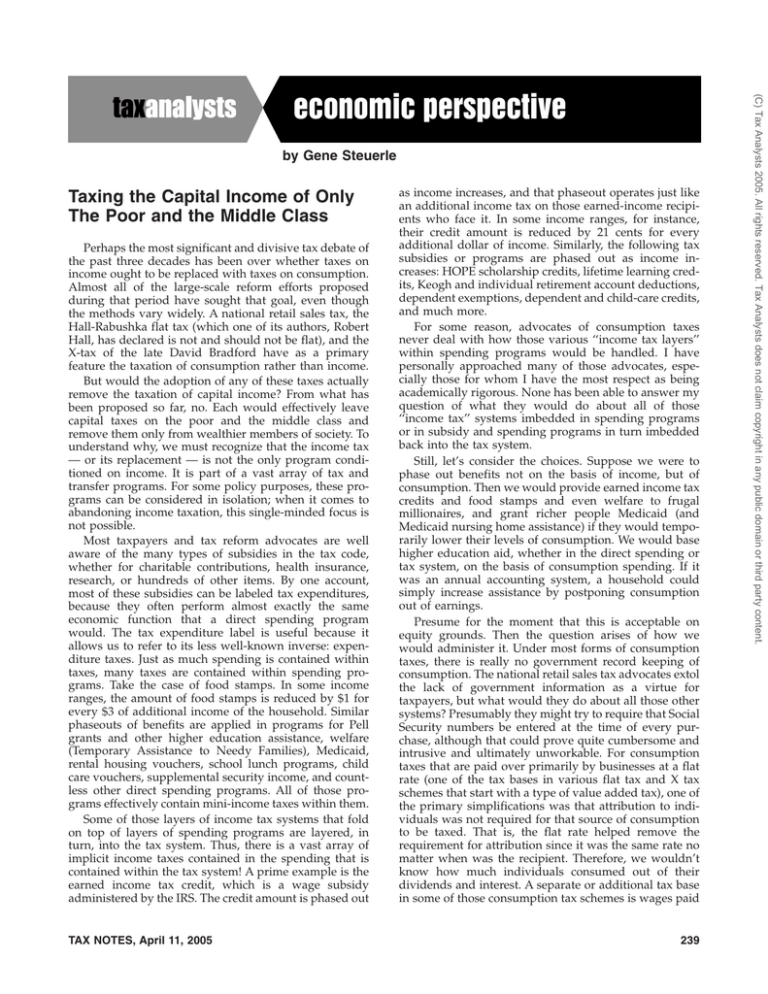
Taxing the Capital Income of Only
The Poor and the Middle Class
Perhaps the most significant and divisive tax debate of
the past three decades has been over whether taxes on
income ought to be replaced with taxes on consumption.
Almost all of the large-scale reform efforts proposed
during that period have sought that goal, even though
the methods vary widely. A national retail sales tax, the
Hall-Rabushka flat tax (which one of its authors, Robert
Hall, has declared is not and should not be flat), and the
X-tax of the late David Bradford have as a primary
feature the taxation of consumption rather than income.
But would the adoption of any of these taxes actually
remove the taxation of capital income? From what has
been proposed so far, no. Each would effectively leave
capital taxes on the poor and the middle class and
remove them only from wealthier members of society. To
understand why, we must recognize that the income tax
— or its replacement — is not the only program conditioned on income. It is part of a vast array of tax and
transfer programs. For some policy purposes, these programs can be considered in isolation; when it comes to
abandoning income taxation, this single-minded focus is
not possible.
Most taxpayers and tax reform advocates are well
aware of the many types of subsidies in the tax code,
whether for charitable contributions, health insurance,
research, or hundreds of other items. By one account,
most of these subsidies can be labeled tax expenditures,
because they often perform almost exactly the same
economic function that a direct spending program
would. The tax expenditure label is useful because it
allows us to refer to its less well-known inverse: expenditure taxes. Just as much spending is contained within
taxes, many taxes are contained within spending programs. Take the case of food stamps. In some income
ranges, the amount of food stamps is reduced by $1 for
every $3 of additional income of the household. Similar
phaseouts of benefits are applied in programs for Pell
grants and other higher education assistance, welfare
(Temporary Assistance to Needy Families), Medicaid,
rental housing vouchers, school lunch programs, child
care vouchers, supplemental security income, and countless other direct spending programs. All of those programs effectively contain mini-income taxes within them.
Some of those layers of income tax systems that fold
on top of layers of spending programs are layered, in
turn, into the tax system. Thus, there is a vast array of
implicit income taxes contained in the spending that is
contained within the tax system! A prime example is the
earned income tax credit, which is a wage subsidy
administered by the IRS. The credit amount is phased out
TAX NOTES, April 11, 2005
as income increases, and that phaseout operates just like
an additional income tax on those earned-income recipients who face it. In some income ranges, for instance,
their credit amount is reduced by 21 cents for every
additional dollar of income. Similarly, the following tax
subsidies or programs are phased out as income increases: HOPE scholarship credits, lifetime learning credits, Keogh and individual retirement account deductions,
dependent exemptions, dependent and child-care credits,
and much more.
For some reason, advocates of consumption taxes
never deal with how those various ‘‘income tax layers’’
within spending programs would be handled. I have
personally approached many of those advocates, especially those for whom I have the most respect as being
academically rigorous. None has been able to answer my
question of what they would do about all of those
‘‘income tax’’ systems imbedded in spending programs
or in subsidy and spending programs in turn imbedded
back into the tax system.
Still, let’s consider the choices. Suppose we were to
phase out benefits not on the basis of income, but of
consumption. Then we would provide earned income tax
credits and food stamps and even welfare to frugal
millionaires, and grant richer people Medicaid (and
Medicaid nursing home assistance) if they would temporarily lower their levels of consumption. We would base
higher education aid, whether in the direct spending or
tax system, on the basis of consumption spending. If it
was an annual accounting system, a household could
simply increase assistance by postponing consumption
out of earnings.
Presume for the moment that this is acceptable on
equity grounds. Then the question arises of how we
would administer it. Under most forms of consumption
taxes, there is really no government record keeping of
consumption. The national retail sales tax advocates extol
the lack of government information as a virtue for
taxpayers, but what would they do about all those other
systems? Presumably they might try to require that Social
Security numbers be entered at the time of every purchase, although that could prove quite cumbersome and
intrusive and ultimately unworkable. For consumption
taxes that are paid over primarily by businesses at a flat
rate (one of the tax bases in various flat tax and X tax
schemes that start with a type of value added tax), one of
the primary simplifications was that attribution to individuals was not required for that source of consumption
to be taxed. That is, the flat rate helped remove the
requirement for attribution since it was the same rate no
matter when was the recipient. Therefore, we wouldn’t
know how much individuals consumed out of their
dividends and interest. A separate or additional tax base
in some of those consumption tax schemes is wages paid
239
(C) Tax Analysts 2005. All rights reserved. Tax Analysts does not claim copyright in any public domain or third party content.
by Gene Steuerle
COMMENTARY / ECONOMIC PERSPECTIVE
240
those now applied to income, but to continue all the
implicit income taxes in the EITC, food stamps, higher
education incentives, housing and health benefits, and so
forth. Then we would need to continue almost in its
entirety an income reporting system that includes capital
income. Separately, we would track consumption for the
new consumption tax system. From what I have seen of
all consumption tax proposals to date, that is implicitly
what they are proposing, at least indirectly. That is, those
proposals do not change the income accounting required
in all those other programs such as food stamps or EITC,
even though they may eliminate the income tax.
Interestingly, the end result of this last system is that
higher-income taxpayers would essentially face a consumption tax on income, at least in the years that their
income was high enough that they were not eligible for
any of the income-conditioned programs.
All the rest — all the lower- and middle-income
households who receive educational or work-related or
child or welfare or health benefits — would remain
primarily in a system that phased out their benefits on
the basis of income. Although they might not need to file
an income tax return with IRS, they would need to fill out
income tax forms for those other programs, because the
IRS form no longer would be available to be sent as a
substitute.
Marginal tax rates — the tax rates paid for earning an
additional dollar — would remain high on capital income
for many of those lower- and middle-income households.
Today those rates rise as high as 50 to 100 percent from all
the phaseouts; if their statutory income tax rate bracket
formerly was 15 percent, their implied marginal income
tax rate from all the other programs might fall to 35 to 85
percent.
Is that what is really sought? Is it to reduce tax on
capital for those who already have a lot of saving and to
keep it high on those who often have very little in the
way of saving? I doubt that’s what those economists and
theoreticians have in mind. But then maybe they are not
really the ones driving the process in the first place. After
all, that is exactly the direction the nation’s tax and
transfer systems have been moving for some time now.
TAX NOTES, April 11, 2005
(C) Tax Analysts 2005. All rights reserved. Tax Analysts does not claim copyright in any public domain or third party content.
out of the business sector, but then many wage earners
save, so information on wages is also inadequate to
measure their level of consumption.
An alternative form of consumption tax requires that
taxpayers and financial intermediaries report to tax authorities on both income and the change in net saving
(such as deposits less withdrawals from accounts — a
limited wealth accounting of sorts). A proposal by former
Sen. Sam Nunn and Sen. Pete Domenici was of that type.
However, in this form of consumption tax, the government really needs both income accounting and partial
wealth accounting for all assets to be able to approximate
consumption at the individual level. For compliance
reasons, it also needs good wealth accounting for the $50
trillion or so of wealth that might be deposited in new
accounts but not represent new saving.
Well, suppose we abandon all attempts to phase out
the availability of benefits on the basis of either income or
consumption, and revert instead to wages as the basis for
measuring when to reduce benefits. Then, of course, rich
people could qualify simply by not working for awhile.
Admittedly, that can already be done by workers who
have no saving; we would simply be adding the wealthy
to the mixture.
How about asset tests? Admittedly, they are horribly
unreliable: Some elderly currently transfer assets to kids
or hide it to qualify for Medicaid. We could extend those
asset tests to almost every form of benefit that is now
income-conditioned, and impose a much stricter accounting system. But then aren’t we really back to income
accounting? Only in this case we essentially are phasing
out benefits on the basis of some imputed income from
wealth rather than on realized income from wealth. It
might even be a fairer system, given that realization of
accrued income from capital is a choice the taxpayer can
make. However, now we have replaced realized income
accounting with wealth and imputed income accounting.
Once again, that raises issues of both complexity and
enforcement that may be worse than the current income
tax accounting on which many systems currently rely.
Another alternative is to use a consumption tax base
for purposes of applying a set of statutory tax rates like



